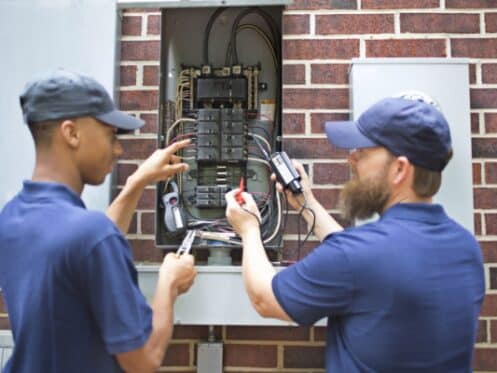A circuit breaker is a device that stops the flow of electricity within a circuit as a protective measure. It shields electrical circuits from damage due to short circuits or overloads. But how much do you know about these breakers?
What a Circuit Breaker Does
A circuit breaker functions as a safety measure to prevent the destruction of the circuits and plugged-in appliances if it is overloaded. They also protect you and your family from electrical shock. Circuit breakers tremendously reduce the risks of fire or damage to electrical equipment caused by a short or overload.
Types of Electricity
Electrical currents can be classified into alternating current (AC) and direct current (DC). Alternating current circuits are utilized in the high operation and power transmission motor devices that cycle between negative and positive voltage several times per second. Most electrical outlets in your home operate on AC power. Direct current circuits are often found in devices such as unlimited power supply units and battery-charged electric unity.
How a Circuit Breaker Operates
Your circuit breaker acts as a traffic cop, monitoring the flow of current and stopping it when it exceeds the allowable limit. This action cuts the power to the offending outlet, and the appliance stops working. There are two main places in your home where you will find circuit breakers: the electrical panel and the outlet.
Types of Circuit Breakers
Being aware of the type of circuit breakers will ensure that you can get the best type for your needs. Some circuit breakers include Standard breakers, Arc Fault Circuit Interrupter (AFCI) circuit breakers, and Ground Fault Interrupter (GFCI) circuit breakers.
Circuit breakers can also be classified according to the voltage, which is outlined as follows:
- High voltage circuit breaker
- Vacuum circuit breaker
- Medium voltage circuit breaker
- Low voltage circuit breaker
Standard Breakers
Standard circuit breakers are comprised of single-pole and double-pole circuit breakers. These are the circuit breakers you find on your home’s electrical panel. An overcharged circuit draws more current than measured, causing excessive heat. This heat could cause appliances and wires to ignite or causes electric shock when touched. This type of breaker also trips when you try to use more appliances than the circuit can handle.
Properly functioning and well-installed circuit breakers can detect power surges and automatically trip when necessary, cutting off the power. Single-pole breakers typically control zones of your home, lighting, and other relatively low-power needs. Single-pole circuit breakers are created to monitor a single wire current and can accommodate 15- to 20 amps while remitting 120 volts to an electric circuit.
Double-pole breakers are used for major appliances like your AC or heating system. Double-pole circuit breakers have two poles that monitor and check the electrical flow across two lines. They are easily distinguished as a single breaker with two side-by-side interconnected switches. The breaker will trip if one or both wires get overloaded and short out. They can handle 15 amps to 200 amps’ while releasing 120/240 or 240 volts to an electric circuit.
Arc Fault Circuit Interrupter
This type of breaker is also located in the electrical panel. Arcing is the process whereby hazardous electrical channels are created between an electrical current and a grounded element. AFCI is triggered when arcing is spotted in the electrical wiring. Arc Fault Circuit Interrupter (AFCI) is designed to protect against these dangerous situations like when an electrical cord’s layer is skinny or breaks, creating a fire risk. The electrical arcs are not detected by double-pole and single-pole circuit breakers, which are at most tripped by high heat.
Ground Fault Circuit Interrupter
Unfortunately, electricity doesn’t always go where it’s supposed to. Sometimes electricity can ground via conductive material, including your body. The Ground Fault Circuit Interrupter (GFCI)’s main objective is to protect against a line-to-ground fault. They work by comparing the flowing current via neutral and hot wires.
GFCIs are required in areas where moisture might be near the electrical circuit. You’ll find this type of circuit breaker in bathrooms, outside lighting, poolside, and the kitchen.
Signs You Need to Replace the Circuit Breaker
Some of the obvious signs that indicate it’s time to replace circuit breakers are as follows:
- Electrical appliances overheating
- Burning smell originating from electrical panel
- Constant tripping
- Circuit breaker too hot to touch
- Frayed wires and burnt materials
- Flickering lights
- Damaged electrical outlets
Electrical Repairs and Upgrades
When you add an extension or a major appliance to your home, you may need an electrician to create an additional breaker at the electrical panel. An electric panel breaker box is an organized-location steel box that holds circuit breakers with power entering through the meter. It is split into different circuits, each with its circuit breaker. Circuit breaker switches are installed within the breaker box, which safeguards electrical components in your home from catching fire or overheating.
Most electrical panels have extra unused slots, so an electrician can add circuits as a home’s needs increase. If there are no empty slots, it’s a bigger and more expensive upgrade project.
You also might need to upgrade a regular outlet to a GFCI outlet. Older homes sometimes still have the two-pronged plugs. When you need to upgrade for safety, you might be able to install GFCIs in all your outlets instead of re-wiring the entire house. This decision should only be made by a qualified electrician.
Always Hire a Professional
When you’re having electrical problems in your home, seeking the services of a certified professional with the expertise and skills required to handle electrical systems is imperative. It will ensure peace of mind, as an electrician can identify the causes and give the best recommendations.
Electricity is dangerous and deadly. Only trained electricians should work with the wiring in your home. For their safety, an electrician will always work with the following tools and safety devices:
- Voltage tester
- Safety goggles
- Rubber mat or plywood to stand on
- Insulated flashlight and screwdriver
- Rubber-sole protective boots
- Insulated wire strippers and hammer
- Cable connectors
Maintenance
As your electrical devices age over time, so do circuit breakers. It is essential to undertake proper routine maintenance measures, including examining all wiring for signs such as discoloration along the terminals or joints.
It is also essential to check every connection regularly to ensure no separate component inside the panel could potentially lead to arcing. Taking precautions and consistent maintenance assists in prolonging the lifespan of your electrical systems, avoiding vital disasters, and saving you money and time.
For the best electrical solutions in Crandall, TX, Accurate Home Services is a phone call away. We are a trusted electrical company with 29 years in the industry. We also install and repair air conditioning and heating systems. Our professional electricians are skilled in lighting installation, electrical panel upgrades, and electric repairs. We also install generators, whole-hope surge protectors, and EV charging stations. For more information regarding electrical systems and circuit breakers, contact Accurate Home Services today.




